The SilverStone SX600-G SFX PSU Review
by E. Fylladitakis on August 21, 2015 8:00 AM EST- Posted in
- PSUs
- Cases/Cooling/PSUs
- 80Plus Gold
- SilverStone
- SFX
- 600W
- Enhance
Hot Test Results
Moving on to our hotbox testing, the SX600-G is only rated for operation up to 40°C, and as we can quickly see in our results it's for a good reason - its performance plummeted once placed in our hotbox. We do not get to review lower power units often here at AnandTech, yet these may be the worst hotbox electrical performance figures we have seen in recent years.
Overall voltage regulation is acceptable, at 2.5% for the 3.3V line and 3.3% for the 5V and 12V lines. The power quality however is terrible. At maximum load, the two minor voltage lines even failed the 50 mV specification limit and the 12V line reached the borderline 114 mV figure with a limit of 120 mV. With the PSU heavily cross-loaded, the 12V line failed the power quality limit as well, registering a ripple of 162 mV. Apparently Enhance just does not expect this PSU to be so heavily loaded under such hot conditions (and, considering the very limited number of connectors, it cannot really be).
| Main Output | ||||||||
| Load (Watts) | 122.57 W | 303.15 W | 449.98 W | 593.93 W | ||||
| Load (Percent) | 20.43% | 50.52% | 75% | 98.99% | ||||
| Amperes | Volts | Amperes | Volts | Amperes | Volts | Amperes | Volts | |
| 3.3 V | 1.79 | 3.39 | 4.47 | 3.35 | 6.71 | 3.32 | 8.95 | 3.31 |
| 5 V | 1.34 | 5.19 | 3.36 | 5.14 | 5.03 | 5.1 | 6.71 | 5.02 |
| 12 V | 8.95 | 12.24 | 22.37 | 12.11 | 33.56 | 11.98 | 44.74 | 11.86 |
| Line | Regulation (20% to 100% load) |
Voltage Ripple (mV) | |||||
| 20% Load | 50% Load | 75% Load | 100% Load | CL1 12V |
CL2 3.3V + 5V |
||
| 3.3V | 2.5% | 24 | 30 | 46 | 64 | 46 | 64 |
| 5V | 3.4% | 30 | 42 | 50 | 72 | 40 | 72 |
| 12V | 3.2% | 32 | 60 | 88 | 114 | 162 | 64 |
We need to stress that this is a PSU rated at 40°C and we perform our testing at temperatures higher than 45°C - we could reduce the ambient temperature of our hotbox testing but we chose not to do so as the results would then not be comparable to those of our previous reviews.
Alongside the regulation and power quality, the energy conversion efficiency plummets as well. The average efficiency reduction is 1.9%, with a high drop of 3.3% at 100% load. The active parts of the PSU are good and such an efficiency loss cannot be attributed solely to them, as they have to cope with very high internal temperatures that reduce the performance of even the best of parts.
This time, the fan of the SX600-G started right away, as the ambient conditions likely were already too harsh for the PSU. With the unit being so densely packed and heavily loaded, the fan has to keep spinning faster and faster in order to cope with the increased thermal demand. It does, maintaining safe operating temperatures for the SX600-G even under the harshest conditions. The strange thing is that even at 100% load, the fan did not reach it maximum rotational speed. With our laser tachometer registering 4200-4300 RPM, it indicates that the fan has headroom to spin even faster if the conditions get harsher than this. Still, it reaches 46.6 dB(A) under maximum load, which the vast majority of users will find intolerable for everyday use.


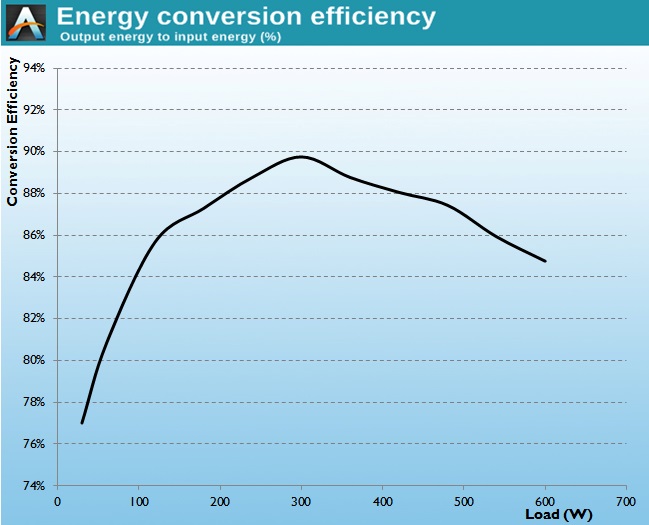
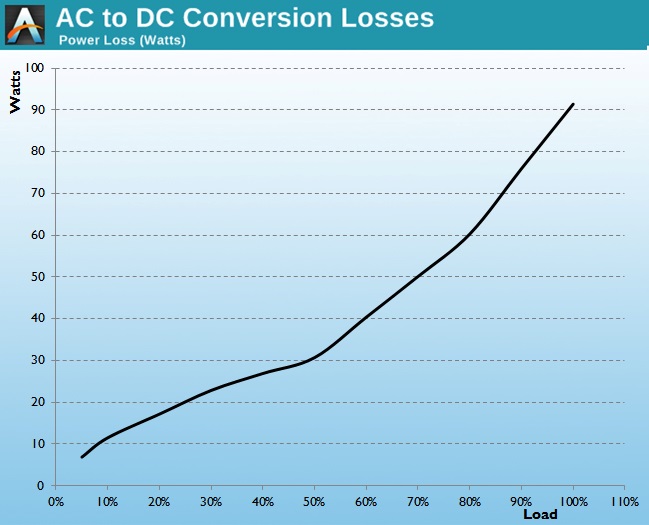
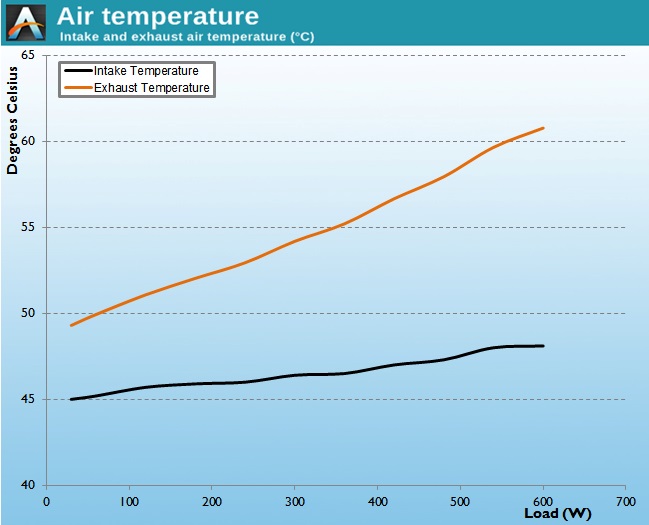
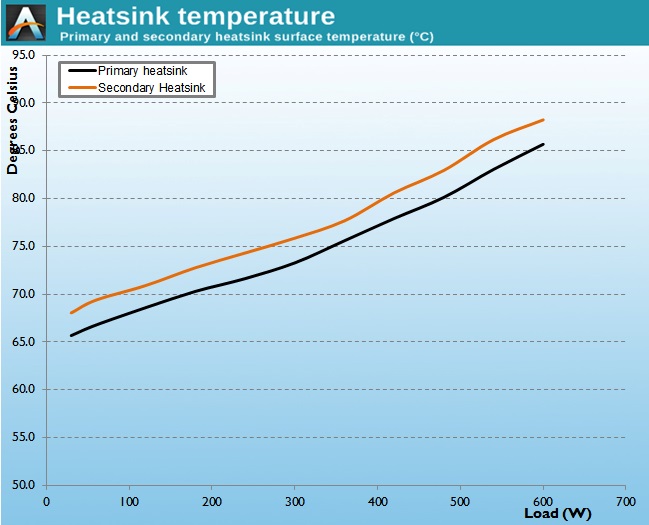
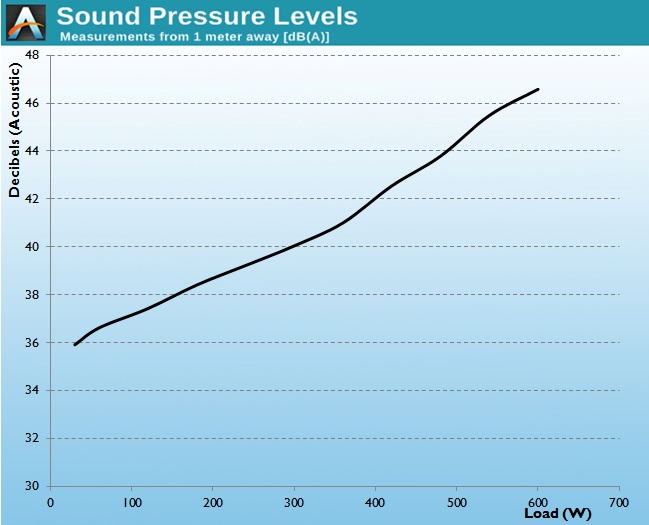








20 Comments
View All Comments
duyfken - Friday, August 21, 2015 - link
Any chance of reviews on the Corsair SF600 (competing 600W SFX and 92mm fan in the SFX form factor with High Power as OEM) or Silverstone SX500-LG (500W Extended SFX form factor with 120mm fan and again the OEM is High Power)?E.Fyll - Saturday, August 22, 2015 - link
It is very likely, yes. One thing at the time.Corsair's model is not available yet.
duyfken - Saturday, August 22, 2015 - link
Cheers, good news for more informed decisions on (many) future iTX builds :)tonyou - Sunday, August 23, 2015 - link
High Power is not the OEM for SF600 (it was in fact Great Wall) according to Corsair's own personnel:http://www.jonnyguru.com/forums/showthread.php?t=1...
StrangerGuy - Saturday, August 22, 2015 - link
I wish SFX is the new mainstream standard for PSUs. The sheer size of ATX PSUs is wastingso much physical space inside a mITX/mATX enclosure, and the vast majority of users simply doesn't need more than 400W even for a gaming PC with power requirements dropping like a rock since 2011.Or even better, a complete move to a +12V DC PSU standard to cut down even more PSU circuitry and save more space at the same time.
sor - Saturday, August 22, 2015 - link
Most power supplies are more efficient at higher voltage, not less. It would be interesting to see you retest at 120vDanNeely - Saturday, August 22, 2015 - link
He can't. He lives in a country with 220V wall power; which means the only way to get 120V is a huge transformer.sor - Saturday, August 22, 2015 - link
Only because it's a quickie review. It wasn't that long ago that I remember seeing PSU reviews here where they were opening them up and critiquing the internals and choices of components, looking at electrical noise of the switching IC, rectifier, and MOSFETs, etc. I think Anandtech could arrange to test a PSU at both common voltages/frequencies if they wanted to make a good quality review. A desktop variac can probably be picked up for the price of this PSU or less and could be used for many reviews. Or perhaps they employ someone stateside who could run a few tests on the same model.I get that this is just a drive-by review for the weekend that isn't intended to be a thorough or high budget affair. And I don't really even know if they're the type who just ships free stuff from manufacturers to your house to try out or if they have invested a couple of hundred into various lab equipment on regular occasion to do proper testing, but I feel like review sites used to lean toward the latter and we are losing that slowly in favor of review mills.
At any rate, the only reason any of this came up is because the reviewer mentioned that it didn't meet 80 plus. That seems like an interesting thing to dig into, because one familiar with power supplies would expect the situation to get worse at 120v.
E.Fyll - Monday, August 24, 2015 - link
Actually, that is entirely wrong. I do have a VARIAC and I do use it to get an exact 230 VAC output. However, dropping the voltage down to 110/120 Volts is just false/fake testing. You see, VARIACs convert the voltage output but do nothing about the frequency. Whoever is claiming to be using a VARIAC for dual voltage testing, sorry, that's just wrong.To perform testing at any voltage/frequency, you need a programmable power source. One in the range of 2-3 KVA costs about $25.000. I do not think that I need to explain why I do not have one.
home improve - Tuesday, August 25, 2015 - link
Depending on the games an individual plays, it is advisable to a high-end graphics card for several reasons such as stereoscopic 3D...<a href="http://www.myhomeimprovementsolutions.com/best-gam... games</a>